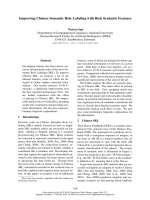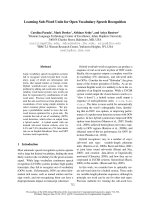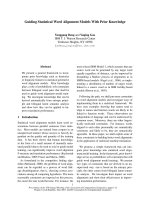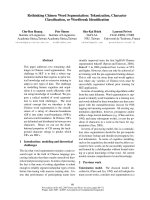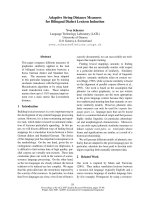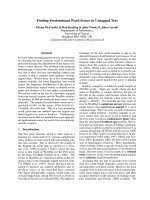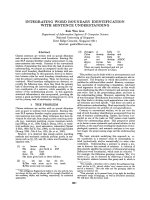Báo cáo khoa học: "Adaptive Chinese Word Segmentation" pptx
Bạn đang xem bản rút gọn của tài liệu. Xem và tải ngay bản đầy đủ của tài liệu tại đây (156.95 KB, 8 trang )
Adaptive Chinese Word Segmentation
1
Jianfeng Gao
*
, Andi Wu
*
, Mu Li
*
, Chang-Ning Huang
*
, Hongqiao Li
**
, Xinsong Xia
$
, Haowei Qin
&
*
Microsoft Research. {jfgao, andiwu, muli, cnhuang}@microsoft.com
**
Beijing Institute of Technology, Beijing.
$
Peking University, Beijing.
&
Shanghai Jiaotong university, Shanghai.
1
This work was done while Hongqiao Li, Xinsong Xia and Haowei Qin were visiting Microsoft Research (MSR) Asia. We thank
Xiaodan Zhu for his early contribution, and the three reviewers, one of whom alerted us the related work of (Uchimoto et al., 2001).
Abstract
This paper presents a Chinese word segmen-
tation system which can adapt to different
domains and standards. We first present a sta-
tistical framework where domain-specific
words are identified in a unified approach to
word segmentation based on linear models.
We explore several features and describe how
to create training data by sampling. We then
describe a transformation-based learning
method used to adapt our system to different
word segmentation standards. Evaluation of
the proposed system on five test sets with dif-
ferent standards shows that the system
achieves state- of-the-art performance on all of
them.
1 Introduction
Chinese word segmentation has been a long-
standing research topic in Chinese language proc-
essing. Recent development in this field shows that,
in addition to ambiguity resolution and unknown
word detection, the usefulness of a Chinese word
segmenter also depends crucially on its ability to
adapt to different domains of texts and different
segmentation standards.
The need of adaptation involves two research
issues that we will address in this paper. The first is
new word detection. Different domains/applications
may have different vocabularies which contain new
words/terms that are not available in a general
dictionary. In this paper, new words refer to OOV
words other than named entities, factoids and mor-
phologically derived words. These words are
mostly domain specific terms (e.g.
蜂窝式 ‘cellular’)
and time-sensitive political, social or cultural terms
(e.g.
三通‘Three Links’, 非典 ‘SARS’).
The second issue concerns the customizable
display of word segmentation. Different Chinese
NLP-enabled applications may have different re-
quirements that call for different granularities of
word segmentation. For example, speech recogni-
tion systems prefer “longer words” to achieve
higher accuracy whereas information retrieval
systems prefer “shorter words” to obtain higher
recall rates, etc. (Wu, 2003). Given a word seg-
mentation specification (or standard) and/or some
application data used as training data, a segmenter
with customizable display should be able to provide
alternative segmentation units according to the
specification which is either pre-defined or implied
in the data.
In this paper, we first present a statistical
framework for Chinese word segmentation, where
various problems of word segmentation are solved
simultaneously in a unified approach. Our ap-
proach is based on linear models where component
models are inspired by the source-channel models
of Chinese sentence generation. We then describe in
detail how the new word identification (NWI)
problem is handled in this framework. We explore
several features and describe how to create training
data by sampling. We evaluate the performance of
our segmentation system using an annotated test set,
where new words are simulated by sampling. We
then describe a transformation-based learning (TBL,
Brill, 1995) method that is used to adapt our system
to different segmentation standards. We compare
the adaptive system to other state-of-the-art systems
using four test sets in the SIGHAN’s First Interna-
tional Chinese Word Segmentation Bakeoff, each of
which is constructed according to a different seg-
mentation standard. The performance of our system
is comparable to the best systems reported on all
four test sets. It demonstrates the possibility of
having a single adaptive Chinese word segmenter
that is capable of supporting multiple user applica-
tions.
Word Class
2
Model Feature Functions, f(S,W)
Context Model Word class based trigram, P(W). -log(P(W))
Lexical Word (LW) 1 if S forms a word lexicon entry, 0 otherwise.
Morphological Word (MW)
1 if S forms a morph lexicon entry, 0 otherwise.
Named Entity (NE) Character/word bigram, P(S|NE). -log(P(S|NE))
Factoid (FT) 1 if S can be parsed using a factoid grammar, 0 otherwise
New Word (NW) Score of SVM classifier
Figure 1: Context model, word classes, and class models, and feature functions.
2
In our system, we define three types of named entity: person name (PN), location name (LN), organization (ON) and translit-
eration name (TN); ten types of factoid: date, time (TIME), percentage, money, number (NUM), measure, e-mail, phone number,
and WWW; and five types of morphologically derived words (MDW): affixation, reduplication, merging, head particle and split.
2 Chinese Word Segmentation with
Linear Models
Let S be a Chinese sentence which is a character
string. For all possible word segmentations W, we
will choose the most likely one W
*
which achieves
the highest conditional probability P(W|S): W
*
=
argmax
w
P(W|S). According to Bayes’ decision rule
and dropping the constant denominator, we can
equivalently perform the following maximization:
)|()(maxarg
*
WSPWPW
W
=
.
(1)
Equation (1) represents a source-channel approach
to Chinese word segmentation. This approach
models the generation process of a Chinese sen-
tence: first, the speaker selects a sequence of con-
cepts W to output, according to the probability
distribution P(W); then he attempts to express each
concept by choosing a sequence of characters,
according to the probability distribution P(S|W).
We define word class as a group of words that
are supposed to be generated according to the same
distribution (or in the same manner). For instance,
all Chinese person names form a word class. We
then have multiple channel models, each for one
word class. Since a channel model estimates the
likelihood that a character string is generated given
a word class, it is also referred to as class model.
Similarly, source model is referred to as context
model because it indicates the likelihood that a word
class occurs in a context. We have only one context
model which is a word-class-based trigram model.
Figure 1 shows word classes and class models that
we used in our system. We notice that different
class models are constructed in different ways (e.g.
name entity models are n-gram models trained on
corpora whereas factoid models use derivation rules
and have binary values). The dynamic value ranges
of different class models can be so different that it is
improper to combine all models through simple
multiplication as Equation (1).
In this study we use linear models. The method
is derived from linear discriminant functions widely
used for pattern classification (Duda et al., 2001),
and has been recently introduced into NLP tasks by
Collins and Duffy (2001). It is also related to log-
linear models for machine translation (Och, 2003).
In this framework, we have a set of M+1 feature
functions f
i
(S,W), i = 0,…,M. They are derived from
the context model (i.e. f
0
(W)) and M class models,
each for one word class, as shown in Figure 1: For
probabilistic models such as the context model or
person name model, the feature functions are de-
fined as the negative logarithm of the corresponding
probabilistic models. For each feature function,
there is a model parameter λ
i
. The best word seg-
mentation W
*
is determined by the decision rule as
∑
=
==
M
i
ii
W
M
W
WSfWSScoreW
0
0
*
),(maxarg),,(maxarg
λλ
(2)
Below we describe how to optimize λs. Our
method is a discriminative approach inspired by the
Minimum Error Rate Training method proposed in
Och (2003). Assume that we can measure the
number of segmentation errors in W by comparing it
with a reference segmentation R using a function
Er(R,W). The training criterion is to minimize the
count of errors over the training data as
∑
=
RWS
M
M
SWREr
M
,,
1
1
^
)),(,(minarg
1
λλ
λ
,
(3)
where W is detected by Equation (2). However, we
cannot apply standard gradient descent to optimize
Initialization: λ
0
=α, λ
i
=1, i = 1,…,M.
For t = 1 … T, j = 1 … N
W
j
= argmax ∑ λ
i
f
i
(S
j
,W)
For i = 1… M
λ
i
= λ
i
+
η
(Score(λ,S,W)-Score(λ,S,R))(f
i
(R) - f
i
(W)),
where λ={λ
0
, λ
1
,…,λ
M
} and
η
=0.001.
Figure 2: The training algorithm for model parameters
model parameters according to Equation (3) be-
cause the gradient cannot be computed explicitly
(i.e., Er is not differentiable), and there are many
local minima in the error surface. We then use a
variation called stochastic gradient descent (or
unthresholded perceptron, Mitchell, 1997). As
shown in Figure 2, the algorithm takes T passes over
the training set (i.e. N sentences). All parameters are
initially set to be 1, except for the context model
parameter
λ
0
which is set to be a constant α during
training, and is estimated separately on held-out
data. Class model parameters are updated in a sim-
ple additive fashion. Notice that Score(
λ,S,W) is not
less than Score(
λ,S,R). Intuitively the updated rule
increases the parameter values for word classes
whose models were “underestimated” (i.e. expected
feature value f(W) is less than observed feature
value f(R)), and decreases the parameter values
whose models were “overestimated” (i.e. f(W) is
larger than f(R)). Although the method cannot
guarantee a global optimal solution, it is chosen for
our modeling because of its efficiency and the best
results achieved in our experiments.
Given the linear models, the procedure of word
segmentation in our system is as follows: First, all
word candidates (lexical words and OOV words of
certain types) are generated, each with its word
class tag and class model score. Second, Viterbi
search is used to select the best W according to
Equation (2). Since the resulting W
*
is a sequence of
segmented words that are either lexical words or
OOV words with certain types (e.g. person name,
morphological words, new words) we then have a
system that can perform word segmentation and
OOV word detection simultaneously in a unified
approach. Most previous works treat OOV word
detection as a separate step after word segmentation.
Compared to these approaches, our method avoids
the error propagation problem and can incorporate a
variety of knowledge to achieve a globally optimal
solution. The superiority of the unified approach
has been demonstrated empirically in Gao et al.
(2003), and will also be discussed in Section 5.
3 New Word Identification
New words in this section refer to OOV words that
are neither recognized as named entities or factoids
nor derived by morphological rules. These words
are mostly domain specific and/or time-sensitive.
The identification of such new words has not been
studied extensively before. It is an important issue
that would have substantial impact on the per-
formance of word segmentation. For example,
approximately 30% of OOV words in the
SIGHAN’s
PK corpus (see Table 1) are new words
of this type. There has been previous work on de-
tecting Chinese new words from a large corpus in
an off-line manner and updating the dictionary
before word segmentation. However, our approach
is able to detect new words on-line, i.e. to spot new
words in a sentence on the fly during the process of
word segmentation where widely-used statistical
features such as mutual information or term fre-
quency are not available.
For brevity of discussion, we will focus on the
identification of 2-character new words, denoted as
NW_11. Other types of new words such as NW_21
(a 2-character word followed with a character) and
NW_12 can be detected similarly (e.g. by viewing
the 2-character word as an inseparable unit, like a
character). Below, we shall describe the class model
and context model for NWI, and the creation of
training data by sampling.
3.1 Class Model
We use a classifier (SVM in our experiments) to
estimate the likelihood of two adjacent characters to
form a new word. Of the great number of features
we experimented, three linguistically-motivated
features are chosen due to their effectiveness and
availability for on-line detection. They are Inde-
pendent Word Probability (IWP), Anti-Word Pair
(AWP), and Word Formation Analogy (WFA).
Below we describe each feature in turn. In Section
3.2, we shall describe the way the training data (new
word list) for the classifier is created by sampling.
IWP is a real valued feature. Most Chinese
characters can be used either as independent words
or component parts of multi-character words, or
both. The IWP of a single character is the likelihood
for this character to appear as an independent word
in texts (Wu and Jiang, 2000):
)(
) ,(
)(
xC
WxC
xIWP =
.
(4)
where C(x, W) is the number of occurrences of the
character x as an independent word in training data,
and C(x) is the total number of x in training data. We
assume that the IWP of a character string is the
product of the IWPs of the component characters.
Intuitively, the lower the IWP value, the more likely
the character string forms a new word. In our im-
plementation, the training data is word-segmented.
AWP is a binary feature derived from IWP. For
example, the value of AWP of an NW_11 candidate
ab is defined as: AWP(ab)=1 if IWP(a)>
θ
or IWP(b)
>
θ
, 0 otherwise.
θ
∈
[0, 1] is a pre-set threshold.
Intuitively, if one of the component characters is
very likely to be an independent word, it is unlikely
to be able to form a word with any other characters.
While IWP considers all component characters in a
new word candidate, AWP only considers the one
with the maximal IWP value.
WFA is a binary feature. Given a character pair
(x, y), a character (or a multi-character string) z is
called the common stem of (x, y) if at least one of the
following two conditions hold: (1) character strings
xz and yz are lexical words (i.e. x and y as prefixes);
and (2) character strings zx and zy are lexical words
(i.e. x and y as suffixes). We then collect a list of
such character pairs, called affix pairs, of which the
number of common stems is larger than a pre-set
threshold. The value of WFA for a given NW_11
candidate ab is defined as: WFA(ab) = 1 if there
exist an affix pair (a, x) (or (b, x)) and the string xb
(or ax) is a lexical word, 0 otherwise. For example,
given an NW_11 candidate
下岗 (xia4-gang3, ‘out of
work’),
we have WFA(下岗) = 1 because (上, 下) is
an affix pair (they have 32 common stems such as
_
任,
游, 台, 车, 面, 午, 班) and 上岗
(shang4-gang3, ‘take over a shift’) is a lexical word.
3.2 Context Model
The motivations of using context model for NWI
are two-fold. The first is to capture useful contex-
tual information. For example, new words are more
likely to be nouns than pronouns, and the POS
tagging is context-sensitive. The second is more
important. As described in Section 2, with a context
model, NWI can be performed simultaneously with
other word segmentation tasks (e.g.: word break,
named entity recognition and morphological analy-
sis) in a unified approach.
However, it is difficult to develop a training
corpus where new words are annotated because “we
usually do not know what we don’t know”. Our
solution is Monte Carlo simulation. We sample a set
of new words from our dictionary according to the
distribution – the probability that any lexical word
w would be a new word P(NW|w). We then generate
a new-word-annotated corpus from a word-seg-
mented text corpus.
Now we describe the way P(NW|w) is estimated.
It is reasonable to assume that new words are those
words whose probability to appear in a new docu-
ment is lower than general lexical words. Let P
i
(k)
be the probability of word w
i
that occurs k times in a
document. In our experiments, we assume that
P(NW|w
i
) can be approximated by the probability of
w
i
occurring less than K times in a new document:
∑
−
=
≈
1
0
)()|(
K
k
ii
kPwNWP
,
(5)
where the constant K is dependent on the size of the
document: The larger the document, the larger the
value. P
i
(k) can be estimated using several term
distribution models (see Chapter 15.3 in Manning
and Schütze, 1999). Following the empirical study
in (Gao and Lee, 2000), we use K-Mixture (Katz,
1996) which estimate P
i
(k) as
k
ki
kP )
1
(
1
)1()(
0,
++
+−=
β
β
β
α
δα
,
(6)
where
δ
k,0
=1 if k=0, 0 otherwise.
α
and
β
are pa-
rameters that can be fit using the observed mean
λ
and the observed inverse document frequency IDF
as follow:
N
cf
=
λ
,
df
N
IDF log=
,
df
dfcf
IDF
−
=−×= 12
λβ
, and
β
λ
α
=
,
where cf is the total number of occurrence of word
w
i
in training data, df is the number of documents in
training data that w
i
occurs in, and N is the total
number of documents. In our implementation, the
training data contain approximately 40 thousand
documents that have been balanced among domain,
style and time.
4 Adaptation to Different Standards
The word segmentation standard (or standard for
brevity) varies from system to system because there
is no commonly accepted definition of Chinese
Condition: ‘Affixation’ Condition: ‘Date’ Condition: ‘PersonName’
Actions: Insert a boundary
between ‘Prefix’ and ‘Stem’…
Actions: Insert a boundary between
‘Year’ and ‘Mon’ …
Actions: Insert a boundary be-
tween ‘FamilyName’ and ‘Given-
Name’…
Figure 3: Word internal structure and class-type transformation templates.
words and different applications may have different
requirements that call for different granularities of
word segmentation.
It is ideal to develop a single word segmentation
system that is able to adapt to different standards.
We consider the following standard adaptation
paradigm. Suppose we have a ‘general’ standard
pre-defined by ourselves. We have also created a
large amount of training data which are segmented
according to this general standard. We then develop
a generic word segmenter, i.e. the system described
in Sections 2 and 3. Whenever we deploy the seg-
menter for any application, we need to customize
the output of the segmenter according to an appli-
cation-specific standard, which is not always ex-
plicitly defined. However, it is often implicitly
defined in a given amount of application data
(called adaptation data) from which the specific
standard can be partially learned.
In our system, the standard adaptation is con-
ducted by a postprocessor which performs an or-
dered list of transformations on the output of the
generic segmenter – removing extraneous word
boundaries, and inserting new boundaries – to
obtain a word segmentation that meets a different
standard.
The method we use is transformation-based
learning (Brill, 1995), which requires an initial
segmentation, a goal segmentation into which we
wish to transform the initial segmentation and a
space of allowable transformations (i.e. transfor-
mation templates). Under the abovementioned
adaptation paradigm, the initial segmentation is the
output of the generic segmenter. The goal segmen-
tation is adaptation data. The transformation tem-
plates can make reference to words (i.e. lexicalized
templates) as well as some pre-defined types (i.e.
class-type based templates), as described below.
We notice that most variability in word seg-
mentation across different standards comes from
those words that are not typically stored in the
dictionary. Those words are dynamic in nature and
are usually formed through productive morpho-
logical processes. In this study, we focus on three
categories: morphologically derived words (MDW),
named entities (NE) and factoids.
For each word class that belongs to these cate-
gories
2
, we define an internal structure similar to
(Wu, 2003). The structure is a tree with ‘word class’
as the root, and ‘component types’ as the other
nodes. There are 30 component types. As shown in
Figure 3, the word class
Affixation has three
component types
: Prefix, Stem and Suffix.
Similarl
y, PersonName has two component types
and
Date has nine – 3 as non-terminals and 6 as
terminals. These internal structures are assigned to
words by the generic segmenter at run time.
The transformation templates for words of the
above three categories are of the form:
Condition: word class
Actions:
z Insert – place a new boundary
between two component types.
z Delete – remove an existing
boundary between two component
types.
Since the application of the transformations de-
rived from the above templates are conditioned on
word class and make reference to component types,
we call the templates class-type transformation
templates. Some examples are shown in Figure 3.
In addition, we also use lexicalized transforma-
tion templates as:
z Insert – place a new boundary
between two lemmas.
Mon Day
Pre_Y Pre_MDig_M Dig_D
Year
Date
PersonName
FamilyName GivenName
A
ffixation
Prefix Stem Suffix
Pre_DDig_Y
z Delete – remove an existing
boundary between two lemmas.
Here, lemmas refer to those basic lexical words
that cannot be formed by any productive morpho-
logical process. They are mostly single characters,
bi-character words, and 4-character idioms.
In short, our adaptive Chinese word segmenter
consists of two components: (1) a generic seg-
menter that is capable of adapting to the vocabu-
laries of different domains and (2) a set of output
adaptors, learned from application data, for adapt-
ing to different “application-specific” standards
5 Evaluation
We evaluated the proposed adaptive word seg-
mentation system (henceforth
AWS) using five
different standards. The training and test corpora of
these standards are detailed in Table 1, where
MSR
is defined by ourselves, and the other four are stan-
dards used in SIGHAN’s First International Chi-
nese Word Segmentation Bakeoff (Bakeoff test sets
for brevity, see Sproat and Emperson (2003) for
details).
Corpus Abbrev.
# Tr. Word # Te. Word
‘General’ standard
MSR
20M 226K
Beijing University
PK
1.1M 17K
U. Penn Chinese
Treebank
CTB
250K 40K
Hong Kong City U.
HK
240K 35K
Academia Sinica
AS
5.8M 12K
Table 1: standards and corpora.
MSR is used as the general standard in our ex-
periments, on the basis of which the generic seg-
menter has been developed. The training and test
corpora were annotated manually, where there is
only one allowable word segmentation for each
sentence. The training corpus contains approxi-
mately 35 million Chinese characters from various
domains of text such as newspapers, novels, maga-
zines etc. 90% of the training corpus are used for
context model training, and 10% are held-out data
for model parameter training as shown in Figure 2.
The NE class models, as shown in Figure 1, were
trained on the corresponding NE lists that were
collected separately. The test set contains a total of
225,734 tokens, including 205,162 lexi-
con/morph-lexicon words, 3,703 PNs, 5,287 LNs,
3,822 ONs, and 4,152 factoids. In Section 5.1, we
will describe some simulated test sets that are de-
rived from the
MSR test set by sampling NWs from
a 98,686-entry dictionary.
The four Bakeoff standards are used as ‘specific’
standards into which we wish to adapt the general
standard. We notice in Table 1 that the sizes of
adaptation data sets (i.e. training corpora of the four
Bakeoff standards) are much smaller than that of the
MSR training set. The experimental setting turns
out to be a good simulation of the adaptation para-
digm described in Section 4.
The performance of word segmentation is
measured through test precision (P), test recall (R),
F score (which is defined as 2PR/(P+R)), the OOV
rate for the test corpus (on Bakeoff corpora, OOV is
defined as the set of words in the test corpus not
occurring in the training corpus.), the recall on
OOV words (Roov), and the recall on in-vocabulary
(Riv) words. We also tested the statistical signifi-
cance of results, using the criterion proposed by
Sproat and Emperson (2003), and all results re-
ported in this section are significantly different
from each other.
5.1 NWI Results
This section discusses two factors that we believe
have the most impact on the performance of NWI.
First, we compare methods where we use the NWI
component (i.e. an SVM classifier) as a post-
processor versus as a feature function in the linear
models of Equation (2). Second, we compare dif-
ferent sampling methods of creating simulated
training data for context model. Which sampling
method is best depends on the nature of P(NW|w).
As described in Section 3.2, P(NW|w) is unknown
and has to be approximated by P
i
(k) in our study, so
it is expected that the closer P(NW|w) and P
i
(k) are,
the better the resulting context model. We compare
three estimates of P
i
(k) in Equation (5) using term
models based on Uniform, Possion, and K- Mixture
distributions, respectively.
Table 2 shows the results of the generic seg-
menter on three test sets that are derived from the
MSR test set using the above three different sam-
pling methods, respectively. For all three distribu-
tions, unified approaches (i.e. using NWI compo-
nent as a feature function) outperform consecutive
approaches (i.e. using NWI component as a post-
processor). This demonstrates empirically the
benefits of using context model for NWI and the
unified approach to Chinese word segmentation, as
described in 3.2. We also perform NWI on Bakeoff
AWS w/o NW AWS w/ NW (post-processor) AWS w/ NW (unified approach)
word segmentation
word segmentation
NW word segmentation
NW
# of NW
P% R% P% R% P%
R%
P% R% P% R%
Uniform 5,682 92.6 94.5 94.7 95.2 64.1
66.8
95.1 95.5 68.1 78.4
Poisson 3,862 93.4 95.6 94.5 95.9 61.4
45.6
95.0 95.7 57.2 60.6
K-Mixture
2,915 94.7 96.4 95.1 96.2 44.1
41.5
95.6 96.2 46.2 60.4
Table 2: NWI results on MSR test set, NWI as post-processor versus unified approach
PK CTB
P R F OOV
Roov
Riv
P R F OOV
Roov
Riv
1. AWS w/o adaptation
.824 .854
.839
.069 .320 .861
.799
.818
.809
.181 .624 .861
2. AWS .952 .959
.955
.069 .781 .972
.895
.914
.904
.181 .746 .950
3. AWS w/o NWI .949 .963
.956
.069 .741 .980
.875
.910
.892
.181 .690 .959
4. FMM w/ adaptation
.913 .946
.929
.069 .524 .977
.805
.874
.838
.181 .521 .952
5. Rank 1 in Bakeoff .956 .963
.959
.069 .799 .975
.907
.916
.912
.181 .766 .949
6. Rank 2 in Bakeoff .943 .963
.953
.069 .743 .980
.891
.911
.901
.181 .736 .949
Table 3: Comparison scores for PK open and CTB open.
HK AS
P R F OOV
Roov
Riv
P R F OOV
Roov
Riv
1. AWS w/o adaptation
.819 .822
.820
.071 .593 .840
.832
.838
.835
.021 .405 .847
2. AWS .948 .960
.954
.071 .746 .977
.955
.961
.958
.021 .584 .969
3. AWS w/o NWI .937 .958
.947
.071 .694 .978
.958
.943
.951
.021 .436 .969
4. FMM w/ adaptation
.818 .823
.821
.071 .591 .841
.930
.947
.939
.021 .160 .964
5. Rank 1 in Bakeoff .954 .958
.956
.071 .788 .971
.894
.915
.904
.021 .426 .926
6. Rank 2 in Bakeoff .863 .909
.886
.071 .579 .935
.853
.892
.872
.021 .236 .906
Table 4: Comparison scores for HK open and AS open.
test sets. As shown in Tables 3 and 4 (Rows 2 and 3),
the use of NW functions (via the unified approach)
substantially improves the word segmentation per-
formance.
We find in our experiments that NWs sampled
by Possion and K-Mixture are mostly specific and
time-sensitive terms, in agreement with our intui-
tion, while NWs sampled by Uniform include more
common words and lemmas that are easier to detect.
Consequently, by Uniform sampling, the P/R of
NWI is the highest but the P/R of the overall word
segmentation is the lowest, as shown in Table 2.
Notice that the three sampling methods are not
comparable in terms of P/R of NWI in Table 2
because of different sampling result in different sets
of new words in the test set. We then perform NWI
on Bakeoff test sets where the sets of new words are
less dependent on specific sampling methods. The
results however do not give a clear indication which
sampling method is the best because the test sets are
too small to show the difference. We then leave it to
future work a thorough empirical comparison
among different sampling methods.
5.2 Standard Adaptation Results
The results of standard adaptation on four Bakeoff
test sets are shown in Tables 3 and 4. A set of
transformations for each standard is learnt using
TBL from the corresponding Bakeoff training set.
For each test set, we report results using our system
with and without standard adaptation (Rows 1 and
2). It turns out that performance improves dra-
matically across the board in all four test sets.
For comparison, we also include in each table
the results of using the forward maximum matching
(FMM) greedy segmenter as a generic segmenter
(Row 4), and the top 2 scores (sorted by F) that are
reported in SIGHAN’s First International Chinese
Word Segmentation Bakeoff (Rows 5 and 6). We
can see that with adaptation, our generic segmenter
can achieve state-of-the-art performance on dif-
ferent standards, showing its superiority over other
systems. For example, there is no single segmenter
in SIGHAN’s Bakeoff, which achieved top-2 ranks
in all four test sets (Sproat and Emperson, 2003).
We notice in Table 3 and 4 that the quality of
adaptation seems to depend largely upon the size of
adaptation data: we outperformed the best bakeoff
systems in the
AS set because the size of the adap-
tation data is big while we are worse in the
CTB set
because of the small size of the adaptation data. To
verify our speculation, we evaluated the adaptation
results using subsets of the
AS training set of dif-
ferent sizes, and observed the same trend. However,
even with a much smaller adaptation data set (e.g.
250K), we still outperform the best bakeoff results.
6 Related Work
Many methods of Chinese word segmentation have
been proposed (See Wu and Tseng, 1993; Sproat
and Shih, 2001 for reviews). However, it is difficult
to compare systems due to the fact that there is no
widely accepted standard. There has been less work
on dealing with NWI and standard adaptation.
All feature functions in Figure 1, except the NW
function, are derived from models presented in
(Gao et al., 2003). The linear models are similar to
what was presented in Collins and Duffy (2001). An
alternative to linear models is the log-linear models
suggested by Och (2003). See Collins (2002) for a
comparison of these approaches.
The features for NWI were studied in Wu &
Jiang (2000) and Li et al. (2004). The use of sam-
pling was proposed in Della Pietra et al. (1997) and
Rosenfeld et al. (2001). There is also a related work
on this line in Japanese (Uchimoto et al., 2001).
A detailed discussion on differences among the
four Bakeoff standards is presented in Wu (2003),
which also proposes an adaptive system where the
display of the output can be customized by users.
The method described in Section 4 can be viewed as
an improved version in that the transformations are
learnt automatically from adaptation data. The use
of TBL for Chinese word segmentation was first
suggested in Palmer (1997).
7 Conclusion
This paper presents a statistical approach to adap-
tive Chinese word segmentation based on linear
models and TBL. The system has two components:
A generic segmenter that can adapt to the vocabu-
laries of different domains, and a set of output
adaptors, learned from application data, for adapt-
ing to different “application-specific” standards.
We evaluate our system on five test sets, each cor-
responding to a different standard. We achieve
state-of-the-art performance on all test sets.
References
Brill, Eric. 1995. Transformation-based error-driven
learning and natural language processing: a case study
in Part-of-Speech tagging. In: Computational Linguis-
tics, 21(4).
Collins, Michael and Nigel Duffy. 2001. Convolution
kernels for natural language. In: Advances in Neural
Information Processing Systems (NLPS 14).
Collins, Michael. 2002. Parameter estimation for statis-
tical parsing models: theory and practice of distribu-
tion-free methods. To appear.
Della Pietra, S., Della Pietra, V., and Lafferty, J. 1997.
Inducing features of random fields. In: IEEE Transac-
tions on Pattern Analysis and Machine Intelligence, 19,
380-393.
Duda, Richard O, Hart, Peter E. and Stork, David G.
2001. Pattern classification. John Wiley & Sons, Inc.
Gao, Jianfeng and Kai-Fu Lee. 2000. Distribution based
pruning of backoff language models. In: ACL2000.
Gao, Jianfeng, Mu Li and Chang-Ning Huang. 2003.
Improved source-channel model for Chinese word
segmentation. In: ACL2003.
Katz, S. M. 1996. Distribution of content words and
phrases in text and language modeling, In: Natural
Language Engineering, 1996(2): 15-59
Li, Hongqiao, Chang-Ning Huang, Jianfeng Gao and
Xiaozhong Fan. 2004. The use of SVM for Chinese
new word identification. In: IJCNLP2004.
Manning, C. D. and H. Schütze, 1999. Foundations of
Statistical Natural Language Processing. The MIT
Press.
Mitchell, Tom M. 1997. Machine learning. The
McGraw-Hill Companies, Inc.
Och, Franz. 2003. Minimum error rate training in statis-
tical machine translation. In: ACL2003.
Palmer, D. 1997. A trainable rule-based algorithm for
word segmentation. In: ACL '97.
Rosenfeld, R., S. F. Chen and X. Zhu. 2001. Whole
sentence exponential language models: a vehicle for
linguistic statistical integration. In: Computer Speech
and Language, 15 (1).
Sproat, Richard and Chilin Shih. 2002. Corpus-based
methods in Chinese morphology and phonology. In:
COLING 2002.
Sproat, Richard and Tom Emerson. 2003. The first
international Chinese word segmentation bakeoff. In:
SIGHAN 2003.
Uchimoto, K., S. Sekine and H. Isahara. 2001. The
unknown word problem: a morphological analysis of
Japanese using maximum entropy aided by a diction-
ary. In: EMNLP2001.
Wu, Andi and Zixin Jiang. 2000. Statistically-enhanced
new word identification in a rule-based Chinese system.
In: Proc of the 2rd ACL Chinese Processing Workshop.
Wu, Andi. 2003. Customizable segmentation of mor-
phologically derived words in Chinese. In: Interna-
tional Journal of Computational Linguistics and Chi-
nese Language Processing, 8(1): 1-27.
Wu, Zimin and Gwyneth Tseng. 1993. Chinese text
segmentation for text retrieval achievements and prob-
lems. In: JASIS, 44(9): 532-542.

